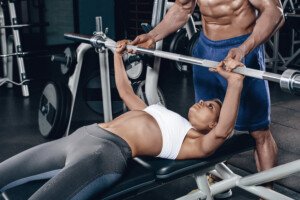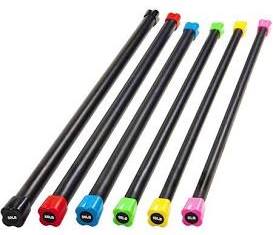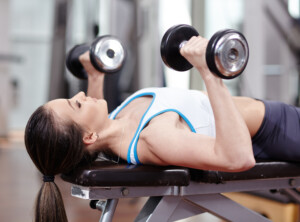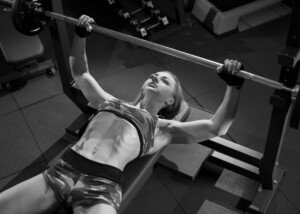
If you’re too weak to bench press an unloaded Olympic bar (45 pounds), here is what you should do to develop the strength to push up that bar without any assistance.
First off, verify that you actually cannot bench press the empty bar. An Olympic bar, unloaded, weighs 45 pounds.
Some women assume they can’t lift it. When I was a personal trainer I met a woman who had made this assumption, and she had felt intimidated by the idea of attempting the move.
The intimidation factor is unique because you’re lying on your back with a weight above your chest and face.
And if you drop it, guess where it will go. It’s not like using a chest press machine where if you can’t push out the weight, you simply bring back the handles; nothing can make contact with your face or chest.
Anyways, I could tell that this woman was strong enough to do the lift, and I told her to have a “What the hell” attitude and “Just do it.” I stood over her but did not touch the unloaded bar.
She got under the bar and grabbed it. To her delight she was strong enough to press the bar.
If you’ve confirmed you’re too weak to bench press the 45 pound bar, then here is what you should do.
Pre-fixed Barbells
Most gyms have a rack with short barbells of pre-fixed weight. These go as low as 20 pounds. Try the 20 pounds first and work your way up from there.

Small Barbells in the Group Fitness Room
Many group fitness classes involve use of short barbells; check the room if there’s a supply of the short empty bars and small plates to add to them.
Then lie on a stepper platform and start pressing, seeing how much you can do.
Smaller Bars
Does your gym have smaller bars, like the ones used for curling? Some small curling bars are straight.
Bring one of these to a bench; sit on the bench, place the bar on your lap, lie down and see if you can press it up.
Work with one of these bars to develop your strength.
Weighted Rods
If your gym doesn’t have small curling bars, see if it has weighted rods.

The heaviest may be only 12 pounds, but at least it will introduce your body to the motion of weighted bench pressing.
In addition to the above, or if your gym doesn’t have these tools, you can develop bench pressing strength by doing seated chest exercises.
You can also do dumbbell presses while lying on a bench.
What about pushups?
Don’t tie up your time struggling with pushups unless you also want to master this exercise.
Otherwise, the struggle will be discouraging because there’s the component of you either can do it or you can’t.
If you’re not strong enough to bench press the 45 pound Olympic bar, you’re not strong enough (nowhere near it, actually) to do a man’s pushup.
You’d be working at knee pushups at that level of weakness. But this will still be demoralizing, since you will know that you’re doing the “girl” version that’s associated with being weak.
It will also be tempting to engage in bad form—even if you don’t realize it. Finally, the progression of upper body strength will be very slow.
Pushups in someone this weak will not be an efficient or fast way to gain upper body strength.
I recommend concentrating on the seated chest press and lying dumbbell press.

Shutterstock/Catalin Petolea
You will not feel discouraged because no matter how weak you are, you will still be able to do these two exercises.
When doing the dumbbell press, bring the weights all the way down. If you bring them only halfway down (because they’re too heavy), then use a lighter weight so that you can bring them all the way down.
When it’s time to try benching the 45 pound Olympic bar, you want to be able to bring it all the way down to your chest.
What about trying to build pressing strength by working with the 45 pound bar only halfway down?
No, no and no. All this will do is train you to get better at only halfway repetitions.
If the bar is too heavy to bring down all the way, you’re not ready for it.
One last bit of advice for women who are too weak to bench press the 45 pound bar: never do shoulder, triceps or biceps exercises before your chest exercises.
The largest muscle group of your session should be the first muscle group worked.
 Lorra Garrick is a former personal trainer certified through the American Council on Exercise. At Bally Total Fitness she trained women and men of all ages for fat loss, muscle building, fitness and improved health.
Lorra Garrick is a former personal trainer certified through the American Council on Exercise. At Bally Total Fitness she trained women and men of all ages for fat loss, muscle building, fitness and improved health.
.

























